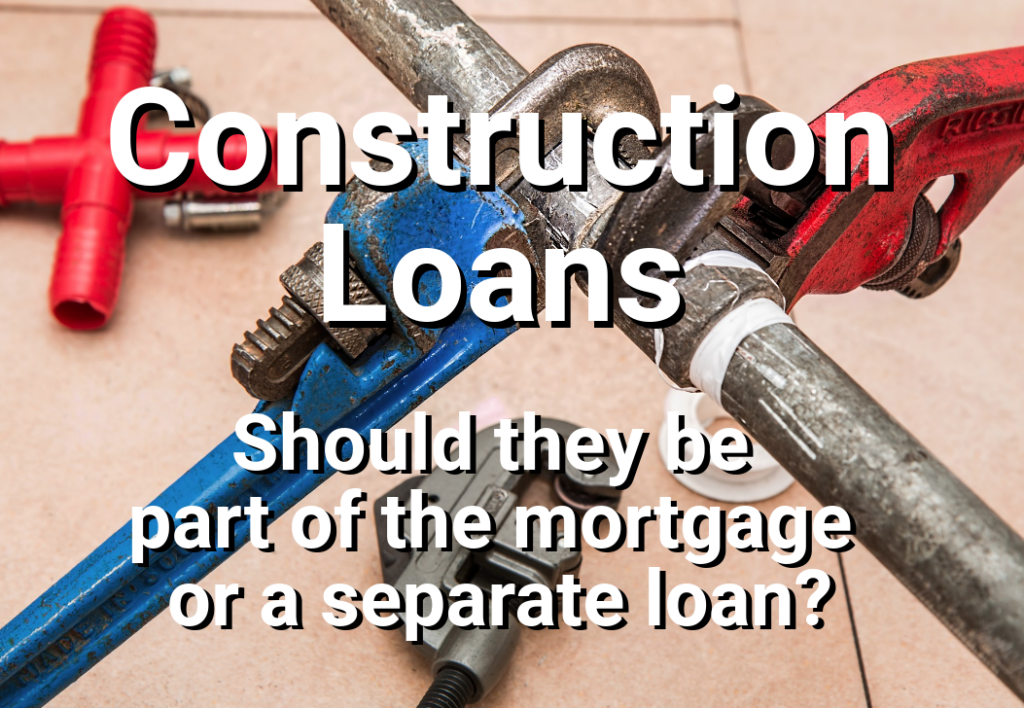You’ve finally found your dream house.
Maybe it’s in a kid-friendly neighborhood, with great schools and a wonderful park just a few blocks down. Maybe it has just the right amount of land for your herb garden and hobby farm. Maybe it has the perfect Victorian wrap-around porch that has always been your dream. Maybe it has the large garage you need for your weekend gear-wrenching.
Whatever the reason, you must have the home.
But unfortunately, it needs significant repairs. The foundation is cracked, the roof is worn, the plumbing is leaking, and the 1950’s electrical wiring is a significant fire hazard.
There are tens of thousands of dollars in necessary repairs, possibly even $100,000 or more, but you don’t have the money on hand. You barely have enough for the down payment, let alone a new retaining wall, roof, and plumbing system!
For most people, this means you will need a construction loan. These loans help you secure the finances required to make the home like-new.
But this raises a new question. Should the construction or renovation loan be part of the mortgage or a separate payment?
Construction Loans: Separate Payment of Part of the Mortgage?
When your new home needs construction and repairs, there are a few different ways to structure the program. First, you can include the finances needed for repairs into the mortgage and have one payment. Second, you can have a loan for the purchase of the property, and a second loan for the construction. As we’ll see, each has it’s advantages and drawbacks.
One Payment
Simplicity is probably the most valuable aspect of one payment. When you take out your initial mortgage, you can work with your lender and add the amount needed for repairs into the total loan. This will allow you to budget and pay on one loan, making your finances more simplified, which is often welcome when you have credit cards, car loans, and other financial obligations.
However, adding the amount needed to cover repairs will increase the loan-to-value, which is an important benchmark for real estate lending. Let’s say you are taking out an $800,000 loan to purchase a home worth $1 million, using $200,000 of your own cash. In this case, the loan-to-value is 80%. However, if you need repairs and take out a loan worth $850,000, (with $50,000 to cover repairs), your loan-to-value is now 85%. This can create higher interest rates and could require you to pay mortgage insurance.
There are many programs that offer repair loans as part of the entire mortgage, including 203(k) loans from the Federal Housing Administration. You can also work with certain lenders to secure a jumbo loan to cover the property purchase and the repairs.
Separate Loans
Having the loan separate from the mortgage will often give you greater flexibility. The amount you take out for your loan won’t impact the specific of your mortgage loan, and you’ll be able to avoid issues such as higher interest rates or mortgage insurance, which can come when you tie the renovation costs into the mortgage itself.
However, a separate loan can, by itself, have higher interest rates than a traditional mortgage. This means you’ll be paying more for every dollar you borrow, and even though the separate loan payments might seem small, they could last for decades.
A Typical Question on Construction Loans:

Here is a typical question related to construction and renovation loans:
Question: I am going to buy a home that needs about $50,000 worth of repairs to make the property into a livable home. Is there a way to add that amount to the mortgages loan, or would it need to be a separate loan?
Answer: A lot will depend on the specific numbers involved in the transaction, including the purchase price, property value, and the loan-to-value ratio.
If you were to purchase a home for a total of $1 million, using an $800,000 loan and personally funding the rest, your loan-to-value ratio would be 80%. However, if you were to tack on another $50,000 for construction and repairs, your loan would be over 80%, which would require a different type of loan. This would result in either lender-paid mortgage insurance, monthly mortgage insurance paid by the borrower, or a Home Equity Line of Credit. In all of these scenarios, you are likely looking at a higher interest rate than you would have if the loan were structured with 20% down.
The situation is certainly not uncommon, and we can always find ways to bring the best possible loan terms. We look at the loan programs with options for less than 20% down when comparing options, allowing you to hold back fund for the repairs instead of a downpayment. In this case, instead of using your own $50,000 (or whatever amount you need) for the downpayment, you would keep the cash on hand for repairs and secure a loan with a smaller down payment.
We can also structure the loan at 20% down (80% loan-to-value), then a week after the close of escrow take out a Home Equity Line of Credit for the balance of cash you would need to complete the repairs. A Home Equity Line of Credit, or “HELOC,” is an effective program that uses equity in your home to finance repairs. (It can also be used for other expenses if you wish.) This program is obviously for people who have gained a significant share of equity in their homes.
Helping You Navigate Construction Loans, Home Repairs, and Mortgages
Financing for home repairs and construction can be difficult. Contact the knowledgable team at San Diego Purchase Loans and we’ll help you understand all the details of renovation loans.
By providing honest, clear information, we can help you decide on one mortgage payment or a separate construction loan. If you decide to move forward, we can also help you get approved for a loan that fits your specific needs!


